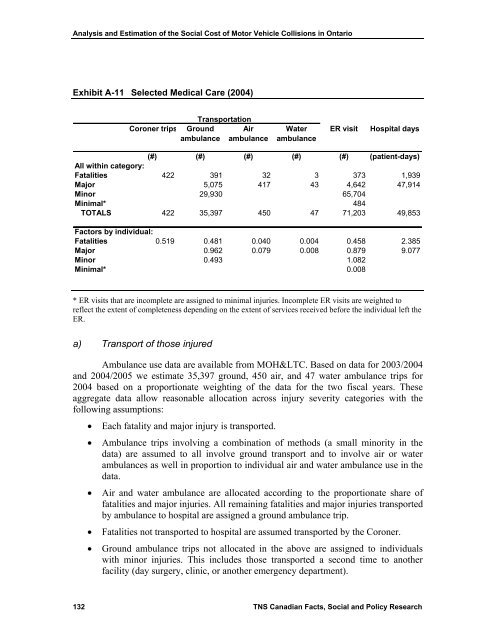Keith Vodden Dr. Douglas Smith - Transports Canada
Keith Vodden Dr. Douglas Smith - Transports Canada
Keith Vodden Dr. Douglas Smith - Transports Canada
You also want an ePaper? Increase the reach of your titles
YUMPU automatically turns print PDFs into web optimized ePapers that Google loves.
Analysis and Estimation of the Social Cost of Motor Vehicle Collisions in Ontario<br />
Exhibit A-11 Selected Medical Care (2004)<br />
Coroner trips<br />
Transportation<br />
Ground<br />
ambulance<br />
Air<br />
ambulance<br />
Water<br />
ambulance<br />
ER visit<br />
Hospital days<br />
(#) (#) (#) (#) (#) (patient-days)<br />
All within category:<br />
Fatalities 422 391 32 3 373 1,939<br />
Major 5,075 417 43 4,642 47,914<br />
Minor 29,930 65,704<br />
Minimal* 484<br />
TOTALS 422 35,397 450 47 71,203 49,853<br />
Factors by individual:<br />
Fatalities 0.519 0.481 0.040 0.004 0.458 2.385<br />
Major 0.962 0.079 0.008 0.879 9.077<br />
Minor 0.493 1.082<br />
Minimal* 0.008<br />
* ER visits that are incomplete are assigned to minimal injuries. Incomplete ER visits are weighted to<br />
reflect the extent of completeness depending on the extent of services received before the individual left the<br />
ER.<br />
a) Transport of those injured<br />
Ambulance use data are available from MOH<C. Based on data for 2003/2004<br />
and 2004/2005 we estimate 35,397 ground, 450 air, and 47 water ambulance trips for<br />
2004 based on a proportionate weighting of the data for the two fiscal years. These<br />
aggregate data allow reasonable allocation across injury severity categories with the<br />
following assumptions:<br />
• Each fatality and major injury is transported.<br />
• Ambulance trips involving a combination of methods (a small minority in the<br />
data) are assumed to all involve ground transport and to involve air or water<br />
ambulances as well in proportion to individual air and water ambulance use in the<br />
data.<br />
• Air and water ambulance are allocated according to the proportionate share of<br />
fatalities and major injuries. All remaining fatalities and major injuries transported<br />
by ambulance to hospital are assigned a ground ambulance trip.<br />
• Fatalities not transported to hospital are assumed transported by the Coroner.<br />
• Ground ambulance trips not allocated in the above are assigned to individuals<br />
with minor injuries. This includes those transported a second time to another<br />
facility (day surgery, clinic, or another emergency department).<br />
132 TNS Canadian Facts, Social and Policy Research
















